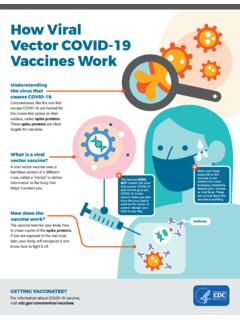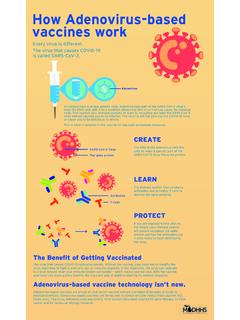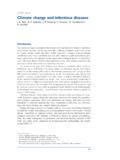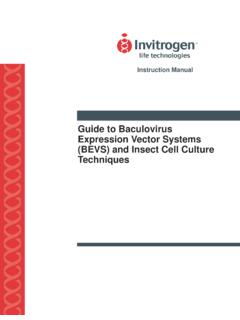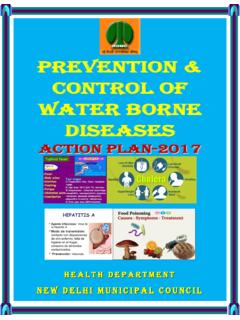Transcription of 10. Vector and pest control - WHO
1 And pest importance of Vector and pest control in disasters and emergenciesSome disasters give rise to increases in the populations of Vector or nuisance species,usually insects or rodents. Floods may create new mosquito breeding sites in disasterrubble and stagnant pools. A general breakdown of sanitation may favour the multipli-cation of houseflies and rodents. People living in partially destroyed houses or primitiveshelters may have lost the normal protection afforded by screened windows or infection hazards may arise when massive migrations bring people of differ-ent origins together in temporary camps infested with disease vectors. Under such conditions, people who are relatively immune carriers of parasites can set off a disease-transmission cycle to which weaker people and people who are not immune fall of disease outbreaks observed in such situations include malaria (transmittedby Anophelesmosquitoes), epidemic typhus (transmitted by lice) and dengue fever (trans-mitted by Aedesmosquitoes).
2 Malaria is one of the five leading causes of mortality in emergency situations, and inendemic areas its control is likely to be one of the main health priorities. The implica-tion of flies in the transmission of diarrhoeal disease is open to some debate, but flycontrol is likely to have a positive impact on health in most postdisaster situations, par-ticularly when sanitary conditions are poor and diarrhoea, Shigelladysentery, or typhoidprevalence are high. Other vectors may be important in specific locations, dependingon the prevalences of the Vector and the disease before the disaster, and the suscepti-bility of the addition to the disease hazards presented by Vector species, many insects and otherarthropods can constitute a major nuisance in disasters. The impact of nuisance furtheradds to the stress and psychosocial instability from which disaster victims usually water rich in organic matter can produce massive numbers of biting midges(Culicoidesspp.)
3 Which do not transmit any disease, but cause extreme nuisance and oftentrigger allergic reactions in sensitive people. Several mosquito species can also be a greatnuisance without presenting a direct risk to health. On the other hand, some of the mostserious disease vectors are hardly considered a nuisance in many areas as their bites arealmost painless ( Anopheles mosquitoes, the vectors of malaria).When wild or domestic host animals have been killed or driven away by disaster,ectoparasites, such as ticks, bugs, lice and fleas, may invade a community and producea serious additional risk of zoonotic Vector -borne disease. Another, related, Vector -bornedisease risk may arise when refugees enter territory formerly occupied only by wildlifeand accompanying parasites. Examples of diseases that may then emerge include plague(from rats) and Lyme disease (from ticks).When action against such pest organisms is considered during disasters, a distinctionmust be made between disease controland nuisance control (see Section ).
4 The vectors likely to be present in emergency settlements and the diseases they carryare shown in Box an early stage in the emergency response, and in planning for possible emergencysettlements, an assessment should be made of Vector -borne disease risks and pest nuisance, and the scope for their control using the techniques available. Special mea-sures for Vector and nuisance pest control (as distinct from general environmental health measures, such as wastewater disposal and excreta disposal) may be expensive and time-consuming, so it is important to know that they are worth carrying out in an emergency, when there are many other health priorities demanding action. As Vector -borne disease risk is a function of the presence of the Vector , the prevalence of the disease organism, and the susceptibility of the population, these three conditions needto be assessed to justify a major environmental management activity.
5 The assessment of Vector -borne disease risk and patterns requires specialist expertise and cooperationbetween the sectors of health, water supply and sanitation, and site selection and control and nuisance controlThe control of a Vector -borne disease can be achieved by various means. In emergen-cies, these include, in order of priority:1. Diagnosis and Vector Environmental Personal controlIn emergencies, nuisance control will not be the most important priority, so targetedapplications of pesticides will seldom be justified. The measures to be taken should aimat medium- and longer-term environmental improvement, in the following order of priority:1. Identification of the causative Environmental Personal : Vector AND PEST CONTROL159 Box and diseases likely to be present in emergency settlementsVectorMain diseasesMosquitoesMalaria, yellow fever, dengue, viral encephalitis, , dysentery, conjunctivitis, typhoid fever, , dysentery, salmonellosis, typhus, pediculosis, relapsing fever, trench fever, skin skin bugsChagas fever, tularaemia, relapsing fever, viral encephalitis, (mites)Rickettsial pox, scrub (fleas)Bubonic plague, endemic bite fever, leptospirosis, salmonellosis, control measuresThis section is concerned primarily with the control of insect vectors.
6 For informationon rodent control , see United Nations High Commissioner for Refugees (1997).Appropriate diagnosis and treatment of patients are possible only in the presence ofadequately trained medical and/or paramedical personnel. Most Vector -borne diseasesrequire a microscopic diagnosis by trained laboratory personnel. Some parasites ( falciparum, which may cause cerebral malaria) may be resistant to most or allavailable drugs. Serious cases of viral Vector -borne infections, such as dengue and yellowfever, require careful clinical management, combined with symptomatic treatment. Ifthese are not available, Vector control becomes even more success of Vector control will depend on reducing the density and longevity ofthe species responsible. In the context of an acute emergency, longevity reduction is generally the more cost-effective option. In contrast, nuisance control is exclusively amatter of density reductionReducing the population density of vectors and nuisance species is achieved by measuresdirected at the breeding sites: environmental management (drainage, filling, levellingof depressions and borrow pits, etc.)
7 Or the use of insecticides (larvicides). In the lattercase, the target organisms must be susceptible to the chemical. In addition, this chemi-cal should not kill nontarget organisms (such as fish) or present a hazard to peopledrinking water from the same source. For further information on density reduction byenvironmental management, see Section reduction with pesticidesLongevity reduction depends on the use of insecticides that kill the adult environmental management is the preferred strategy for reducing vectordensity (Section ), the use of insecticides for longevity reduction is often called forin emergencies, due to the urgent nature of the problem and the risk of epidemics ofvector-borne disease among susceptible for killing adult vectors must be applied in places where the Vector willrest, such as the inside surfaces of houses in the case of Anophelesmosquitoes, or cracksin walls and other hiding places in the case of triatomid bugs.
8 In addition, the targetspecies must be susceptible to the chemical and the chemical must not be a health hazardto the population or personnel carrying out the spraying. The design and implementa-tion of these measures must therefore be the responsibility of specialized following questions must be answered before insecticides are used to controllarvae or adult forms of disease vectors: What is the Vector species responsible for disease transmission among the population? To which insecticides is it susceptible? Where does it breed? Where does it rest? Which is expected to be more cost-effective and rapid: killing larvae or killingadults? Can the required pesticide be obtained in the correct formulation? Is the use of this pesticide to control the target Vector compatible with nationalstrategies for Vector control ? Is the correct equipment available? Are trained personnel available or can they be made available?
9 ENVIRONMENTAL HEALTH IN EMERGENCIES AND DISASTERS160 What precautions must be taken to protect human safety? Will it be possible to adopt more permanent measures (such as personal protec-tion, environmental management, etc.) at a later stage?It is risky and inadvisable to use insecticides unless these questions can be answered sat-isfactorily. Environmental health staff should obtain advice from Vector specialists toanswer many of these questions, via the Ministry of Health, WHO or other organizationswith expertise in this provides information on methods of pesticide application. For further infor-mation on the choice of pesticides, equipment for applying pesticides, and instructionsfor their safe use, see: Chavasse & Yap (1997), Rozendaal (1997), United Nations HighCommissioner for Refugees (1997).Certain pesticides, the persistent organic pesticides such as DDT, are banned orsubject to restrictions in many countries. It is necessary to determine which pesticidescan be used for Vector control in a country affected by a disaster.
10 A pesticide banned foragricultural purposes may be permitted for use in disease control (and vice versa). Mostlegal restrictions are based on assumed or proven hazards to the environment, but someare related to proven human toxicity hazards associated with short exposures. In general,appropriately registered pesticides should not pose an unacceptable risk if properly used. Under the conditions prevailing in emergencies, there is usually no need to usepersistent insecticides; Vector susceptibility is a more critical criterion when selecting specific reference to DDT, the text of the Stockholm Convention on PersistentOrganic Pollutants, agreed in May 2001, contains the following paragraphs that are relevant if indoor residual spraying is part of an emergency response:1. The production and use of DDT shall be eliminated except for Parties that have notified theSecretariat of their intention to produce and/or use it.










